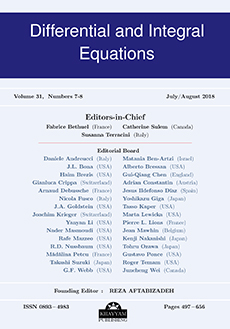Abstract
The non-local parabolic equation \[ v_t=\Delta v+\frac{\lambda e^v}{\int_\Omega e^v}\quad\mbox{in $\Omega\times (0,T)$} \] associated with Dirichlet boundary and initial conditions is considered here. This equation is a simplified version of the full chemotaxis system. Let $\lambda^*$ be such that the corresponding steady-state problem has no solutions for $\lambda>\lambda^*$, then it is expected that blow-up should occur in this case. In fact, for $\lambda>\lambda^*$ and any bounded domain $\Omega\subset {\bf R}^2$ it is proven, using Trudinger-Moser's inequality, that $\int_{\Omega} e^{v(x,t)}dx\to \infty$ as $t\to T_{max}\leq \infty.$ Moreover, in this case, some properties of the blow-up set are provided. For the two-dimensional radially symmetric problem, i.e. when $\Omega=B(0,1),$ where it is known that $\lambda^*=8\,\pi,$ we prove that $v$ blows up in finite time $T^* < \infty$ for $\lambda>8\,\pi$ and this blow-up occurs only at the origin $r=0$ (single-point blow-up, mass concentration at the origin).
Citation
Nikos I. Kavallaris. Takashi Suzuki. "On the finite-time blow-up of a non-local parabolic equation describing chemotaxis." Differential Integral Equations 20 (3) 293 - 308, 2007. https://doi.org/10.57262/die/1356039503
Information





